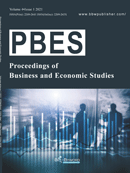Research on the Third-Person Effect of Online Commercial Advertisements – Based on the Students from Guangzhou Huashang College
Abstract
The third-person effect hypothesis has become one of the most important aspects in the research field within the American empirical school. A large number of studies have adopted empirical research methods to verify the reliability of the third-person effect. With the rise of the network society, local research on the third-person effect has gradually extended to the verification or falsification of the third-person effect in the network environment. This article begins with a study on the third-person effect of online commercial advertisements based on the students from Guangzhou Huashang College. Through the study, the research hypotheses have been proposed and questionnaires have been distributed to the research subjects for analysis. Based on a series of quantitative operations, such as data analysis, empirical observations, and empirical research, this study provides a source of reference and reflection for research in this field.
References
Davison WP, 1983, The Third-Person Effect in Communication. Public Opinion Quarterly, 47(1): 1-15.
Gunther AC, 1991, What We Think Others Think: Cause and Consequence in the Third-Person Effect. Communication Research, 18(3): 355-372.
Perloff RM, 1993, Third Person Effect Research 1983-1992: A Review and Synthesis. International Journal of Public Opinion Research, 5(2): 167-184.
Atwood LE, 1994, Illusions of Media Power: The Third-Person Effect. Journalism Quarterly, 71(2): 269-281.
Eveland WP, McLeod DM, 1999, The Effect of Social Desirability on Perceived Media Impact: Implications for Third-Person Perceptions. International Journal of Public Opinion Research, 11(4): 315-333.
Eastin MS, LaRose ER, 2000, Internet Self-Efficacy and the Psychology of the Digital Divide. Journal of Computer-Mediated Communication, 6(1): 0-0.

